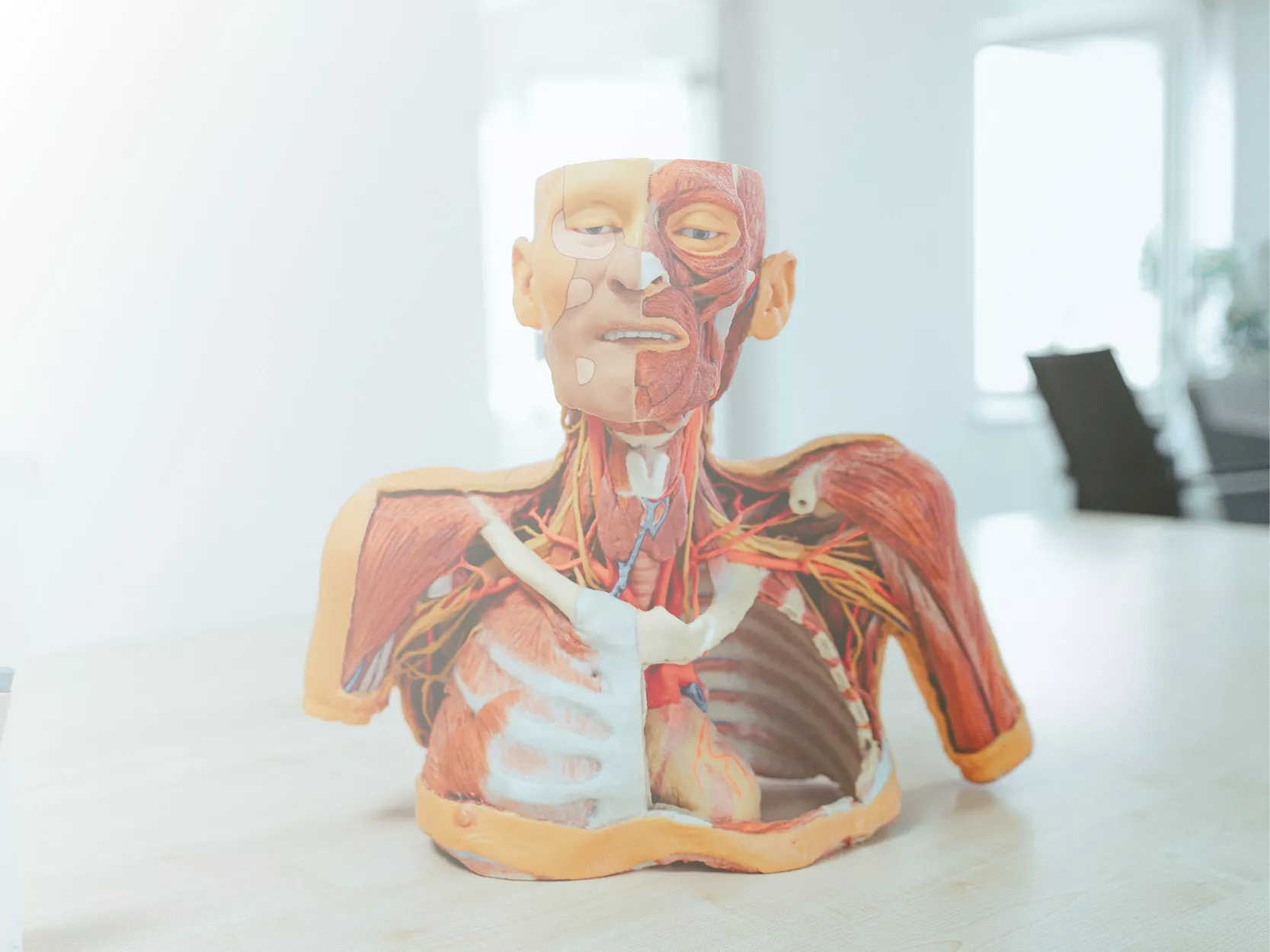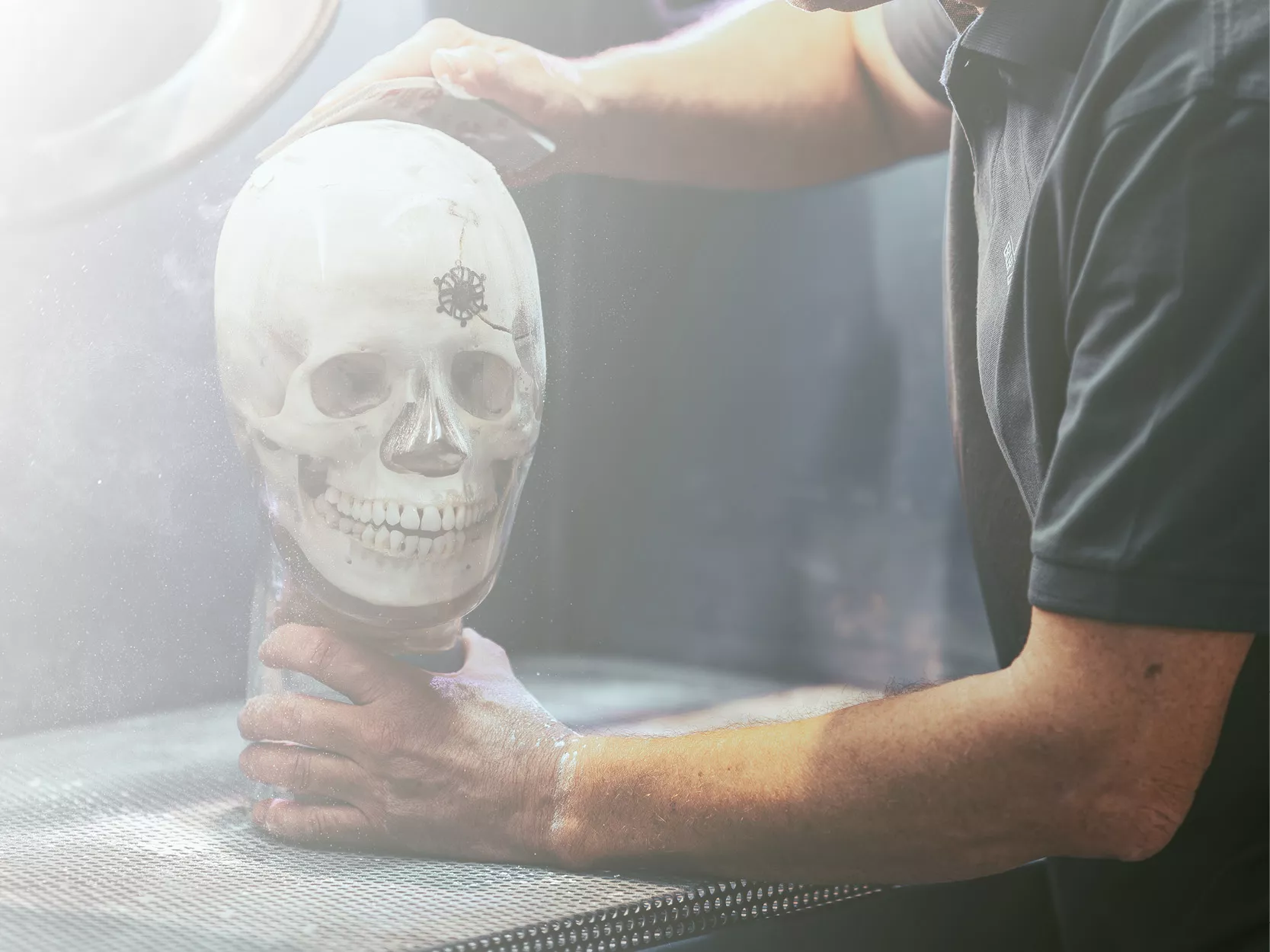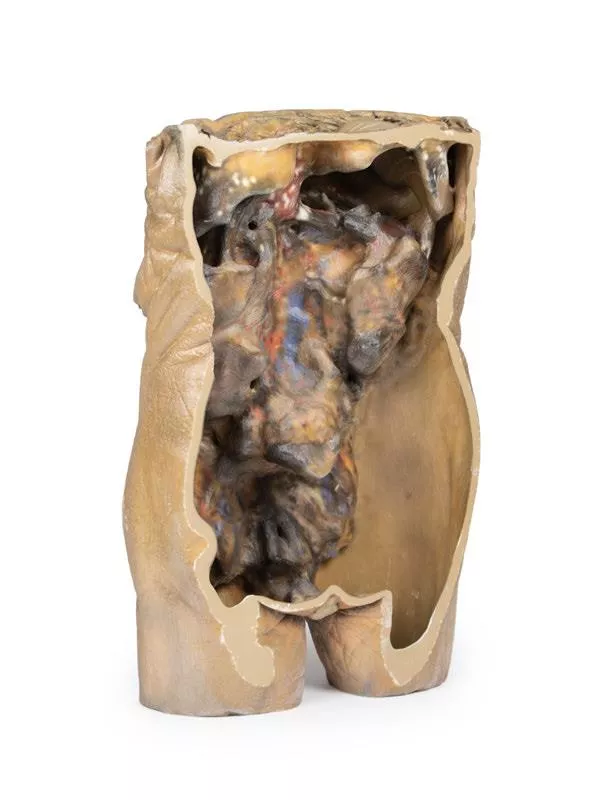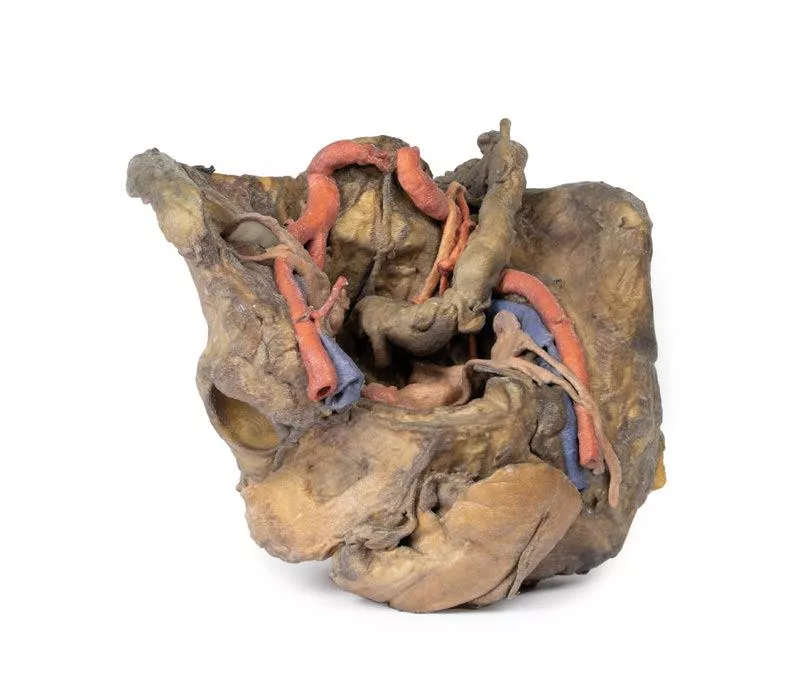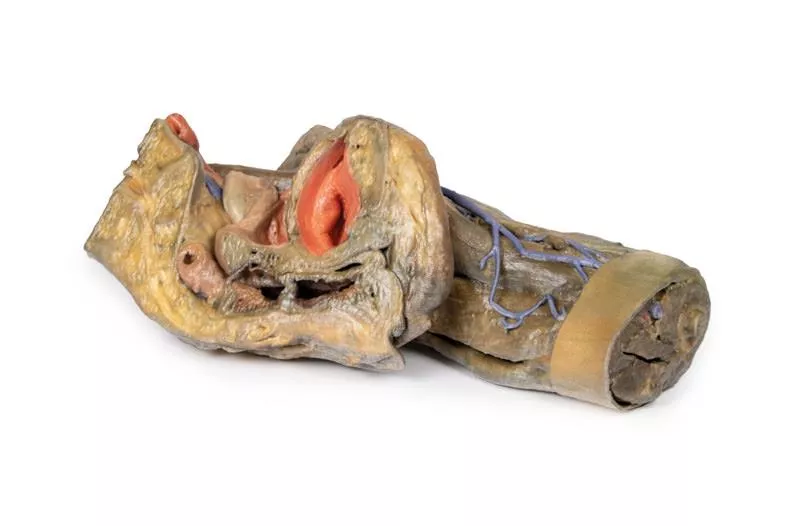Produktinformationen "Abdomen with bilateral Hernias"
Dieses 3D-Modell ist eines der größten und komplexesten der Serie und besteht aus einem Teil des Rumpfes vom Zwerchfell bis zum proximalen Oberschenkel mit einer vollständigen Bauchhöhle, in der verschiedene Stadien der Dissektion erhalten sind. Dieses 3D-Modell zeigt auch das seltene gleichzeitige Auftreten von indirekten und direkten Leistenbrüchen, wodurch die anatomischen Grundlagen beider Erkrankungen berücksichtigt werden können. Angesichts des Umfangs der Präparation ist die Beschreibung dieses 3D-Modells in einzelne Teile unterteilt, die sich nach Ansichten und Regionen richten.
Das Zwerchfell
Das Zwerchfell ist auf der Oberseite des Modells erhalten geblieben, wobei sowohl die Kuppeln als auch die costodiaphragmatischen Vertiefungen trotz einer gewissen Verzerrung durch die Entfernung der Rippen sichtbar sind. Das fibröse Perikard liegt auf dem zentralen Sehnenstrang, wobei die terminale untere Hohlvene im Foramen cavale zu sehen ist. Seitlich davon liegen die Speiseröhre im Hiatus oesophageus und die absteigende thorakale Aorta, die sich dem Hiatus aorticus in der Nähe der Wirbel nähert.
Die epigastrische und hypochondrische Region
Im Abdomen werden durch die Entfernung der vorderen Wand, des Omentum majus und eines Großteils des Magen-Darm-Trakts die retroperitonealen Strukturen freigelegt. Der terminale Ösophagus mündet links neben der Leber. Nach Entfernung des Magens liegt die Bauchspeicheldrüse von Kopf bis Schwanz vollständig frei und reicht bis zur Milz im linken Hypochondrium. Oberhalb davon überspannen die Milz- und die gemeinsame Leberarterie den engen Raum zwischen Bauchspeicheldrüse, Zwerchfell und Leber. Die gewundene Milzarterie teilt sich in der Nähe der Milzvene; aus der gemeinsamen Leberarterie entspringen die gastroduodenale und die rechte Magenarterie, oberflächlich zur Pfortader. Die oberen Mesenterialgefäße verlaufen in der Nähe des Pankreaskopfes, und die Ileokolische Arterie führt zum Blinddarm. Die Vena mesenterica inferior entspringt aus der Vena rectalis superior und kreuzt die Aorta descendens.
Unterhalb der Leber liegt die Gallenblase zwischen den Lappen. Auf der linken Seite verlaufen die Nierengefäße tief zum Pankreas, wobei die Harnleiter über die Psoas-Muskeln hinabführen.
Die Nabel- und Lendenregion
Die meisten Bauchorgane in der Nabel- und Lendenregion wurden entfernt, um die hintere Bauchwand freizulegen. In der Mitte sind die absteigende Aorta und die untere Hohlvene deutlich zu erkennen, wobei die Hodengefäße bis zur Leistengegend verfolgt werden können. Zwei rechte Lendenarterien zweigen von der Aorta ab, und aus der unteren Mesenterialarterie entspringen die linke Kolikarterie, die Sigmoidarterie und die obere Rektalarterie. Auf der rechten Seite sind die Nerven subcostalis, iliohypogastricus und ilioinguinalis sowie die Arteria circumflexa iliaca sichtbar.
Der Unterbauch und die Beckenregion
Die Bauchaorta verzweigt sich in die Arteria iliaca communis, die Arteria iliaca interna und die Arteria iliaca externa, wobei die entsprechenden Venen iliacae in die Vena cava inferior münden. Die Arteria obturatoria, die Harnleiter und die Hodenarterien sind sichtbar. Im echten Becken bedeckt das Peritoneum die Blase, während das Rektum verdeckt bleibt. Die rechte Fossa iliaca enthält das terminale Ileum, das Caecum und den Appendix mit den nahe gelegenen Gefäßen und Nerven. Auf der linken Seite kreuzt das Sigmoid die Fossa iliaca, wo sich ein Epiploic-Anhang in eine indirekte Hernie in der Nähe der A. epigastrica inferior erstreckt.
Die Leistengegend und der Damm
Dieses Modell zeigt sowohl direkte (rechts) als auch indirekte (links) Leistenhernien, wobei die unteren epigastrischen Gefäße zur anatomischen Orientierung erhalten geblieben sind. Die rechte Hernie liegt medial zu diesen Gefäßen; der linke Bruchsack erstreckt sich lateral in den Samenstrang hinein und enthält einen Epiploonfortsatz. Das Perineum zeigt den Penis, die Hoden und die Samenstränge. Auf der rechten Seite ist der Strang intakt, auf der linken Seite ist er geöffnet und zeigt eine variköse Hodenvene, die mit der indirekten Hernie verbunden ist.
Der Oberschenkel
Das Femurdreieck wurde an beiden Oberschenkeln präpariert. Auf der rechten Seite wurde die Femurscheide entfernt, um die Femoralarterie, die Vene, die tiefen Leistenlymphknoten und den Femoralnerv freizulegen. Auf der linken Seite zeigt eine breitere Ansicht die vorderen und medialen Oberschenkelmuskeln, wobei die Femoralarterie, die Arteria profunda femoris und die Arteria circumflexa iliaca sichtbar sind. Das Modell endet in der Mitte des Oberschenkels und zeigt die Querschnittsanatomie einschließlich des Femurschafts, der Gefäße und der Muskeln im subsartorialen Kanal.
Das Zwerchfell
Das Zwerchfell ist auf der Oberseite des Modells erhalten geblieben, wobei sowohl die Kuppeln als auch die costodiaphragmatischen Vertiefungen trotz einer gewissen Verzerrung durch die Entfernung der Rippen sichtbar sind. Das fibröse Perikard liegt auf dem zentralen Sehnenstrang, wobei die terminale untere Hohlvene im Foramen cavale zu sehen ist. Seitlich davon liegen die Speiseröhre im Hiatus oesophageus und die absteigende thorakale Aorta, die sich dem Hiatus aorticus in der Nähe der Wirbel nähert.
Die epigastrische und hypochondrische Region
Im Abdomen werden durch die Entfernung der vorderen Wand, des Omentum majus und eines Großteils des Magen-Darm-Trakts die retroperitonealen Strukturen freigelegt. Der terminale Ösophagus mündet links neben der Leber. Nach Entfernung des Magens liegt die Bauchspeicheldrüse von Kopf bis Schwanz vollständig frei und reicht bis zur Milz im linken Hypochondrium. Oberhalb davon überspannen die Milz- und die gemeinsame Leberarterie den engen Raum zwischen Bauchspeicheldrüse, Zwerchfell und Leber. Die gewundene Milzarterie teilt sich in der Nähe der Milzvene; aus der gemeinsamen Leberarterie entspringen die gastroduodenale und die rechte Magenarterie, oberflächlich zur Pfortader. Die oberen Mesenterialgefäße verlaufen in der Nähe des Pankreaskopfes, und die Ileokolische Arterie führt zum Blinddarm. Die Vena mesenterica inferior entspringt aus der Vena rectalis superior und kreuzt die Aorta descendens.
Unterhalb der Leber liegt die Gallenblase zwischen den Lappen. Auf der linken Seite verlaufen die Nierengefäße tief zum Pankreas, wobei die Harnleiter über die Psoas-Muskeln hinabführen.
Die Nabel- und Lendenregion
Die meisten Bauchorgane in der Nabel- und Lendenregion wurden entfernt, um die hintere Bauchwand freizulegen. In der Mitte sind die absteigende Aorta und die untere Hohlvene deutlich zu erkennen, wobei die Hodengefäße bis zur Leistengegend verfolgt werden können. Zwei rechte Lendenarterien zweigen von der Aorta ab, und aus der unteren Mesenterialarterie entspringen die linke Kolikarterie, die Sigmoidarterie und die obere Rektalarterie. Auf der rechten Seite sind die Nerven subcostalis, iliohypogastricus und ilioinguinalis sowie die Arteria circumflexa iliaca sichtbar.
Der Unterbauch und die Beckenregion
Die Bauchaorta verzweigt sich in die Arteria iliaca communis, die Arteria iliaca interna und die Arteria iliaca externa, wobei die entsprechenden Venen iliacae in die Vena cava inferior münden. Die Arteria obturatoria, die Harnleiter und die Hodenarterien sind sichtbar. Im echten Becken bedeckt das Peritoneum die Blase, während das Rektum verdeckt bleibt. Die rechte Fossa iliaca enthält das terminale Ileum, das Caecum und den Appendix mit den nahe gelegenen Gefäßen und Nerven. Auf der linken Seite kreuzt das Sigmoid die Fossa iliaca, wo sich ein Epiploic-Anhang in eine indirekte Hernie in der Nähe der A. epigastrica inferior erstreckt.
Die Leistengegend und der Damm
Dieses Modell zeigt sowohl direkte (rechts) als auch indirekte (links) Leistenhernien, wobei die unteren epigastrischen Gefäße zur anatomischen Orientierung erhalten geblieben sind. Die rechte Hernie liegt medial zu diesen Gefäßen; der linke Bruchsack erstreckt sich lateral in den Samenstrang hinein und enthält einen Epiploonfortsatz. Das Perineum zeigt den Penis, die Hoden und die Samenstränge. Auf der rechten Seite ist der Strang intakt, auf der linken Seite ist er geöffnet und zeigt eine variköse Hodenvene, die mit der indirekten Hernie verbunden ist.
Der Oberschenkel
Das Femurdreieck wurde an beiden Oberschenkeln präpariert. Auf der rechten Seite wurde die Femurscheide entfernt, um die Femoralarterie, die Vene, die tiefen Leistenlymphknoten und den Femoralnerv freizulegen. Auf der linken Seite zeigt eine breitere Ansicht die vorderen und medialen Oberschenkelmuskeln, wobei die Femoralarterie, die Arteria profunda femoris und die Arteria circumflexa iliaca sichtbar sind. Das Modell endet in der Mitte des Oberschenkels und zeigt die Querschnittsanatomie einschließlich des Femurschafts, der Gefäße und der Muskeln im subsartorialen Kanal.
🔬 3D-Anatomie-Reihe – Nachbildungen des menschlichen Körpers!
26. August 2025
Entdecken Sie exklusive 3D-gedruckte Modelle des menschlichen Körpers – aus echten Präparaten erstellt.
Erler-Zimmer
Erler-Zimmer GmbH & Co.KG
Hauptstrasse 27
77886 Lauf
Germany
info@erler-zimmer.de
Achtung! Medizinisches Ausbildungsmaterial, kein Spielzeug. Nicht geeignet für Personen unter 14 Jahren.
Attention! Medical training material, not a toy. Not suitable for persons under 14 years of age.






